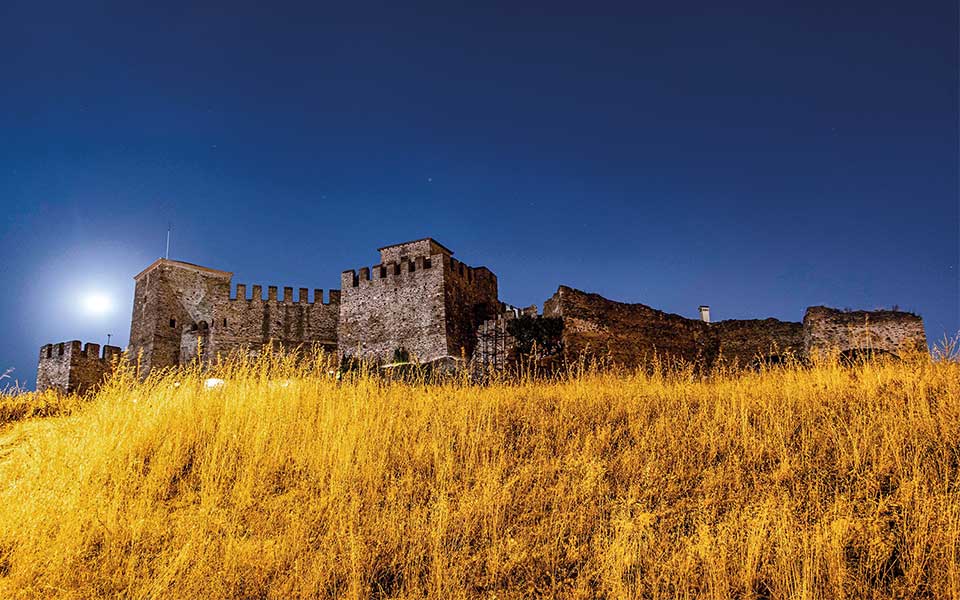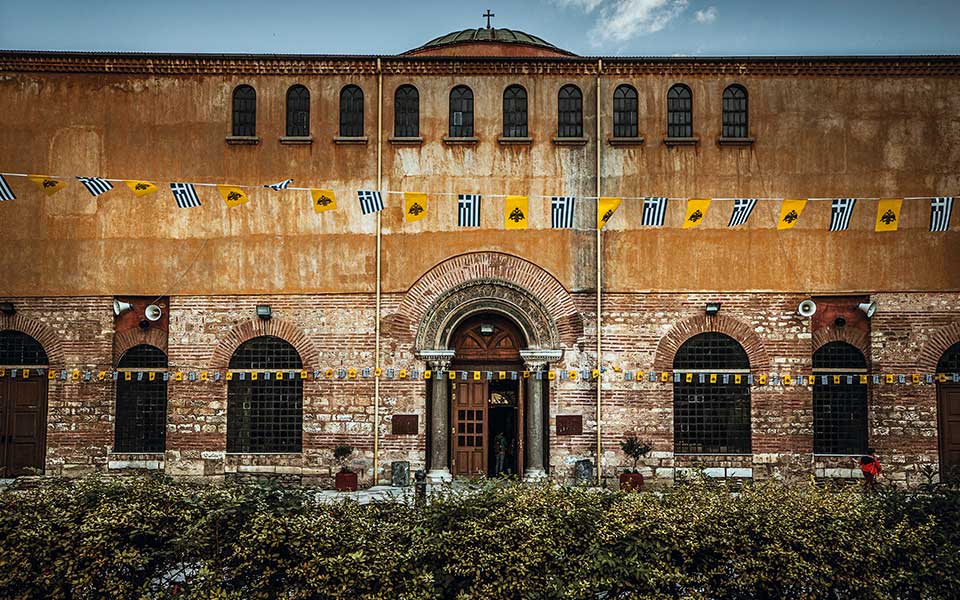The Many Gazes of Little Miss Grumpy
Illustrator Maria Pagkalou draws enchanting portraits...

Interior of the Pantheon-like Rotunda.
© HELLENIC MINISTRY OF CULTURE & SPORTS/Ephorate of Antiquities of the City of Thessaloniki, Getty Images/Ideal Image
As the pandemic continues to change our daily routines, we look around for a sense of stability, of reliable permanence. In Thessaloniki, there is so much to marvel at which has endured, as we look with fresh eyes on this great city rich in history, culture and art. Sounds, too, carry renewed meaning and appreciation. Amid the usual urban din, the pealing of church bells reverberating from Thessaloniki’s beautifully preserved, age-old places of worship reminds us of the importance of life, community and what can be accomplished together, both in times of well-being and of trouble. It is the Byzantine monuments of Thessaloniki, in particular, that give the city its unique, timeless character.

Eptapirgio Castle, formerly the notorious Yenti Kule prison.
© Getty Images/Ideal Image


The Rotunda wall mosaic, an unidentified military man (early 4th-mid-6th c.).
© HELLENIC MINISTRY OF CULTURE & SPORTS/Ephorate of Antiquities of the City of Thessaloniki, Getty Images/Ideal Image
Thessaloniki’s long, tumultuous yet spiritually and artistically vibrant past constitutes one of its most intriguing aspects. Even before it was conquered by the Ottoman Turks in 1430, the city had flourished, declined, rebounded from hardship and flourished again numerous times during the 17 centuries since its foundation by Alexander the Great’s successor, Cassander, in 315 BC. This is what makes European tourism so interesting – the cities are old, evocative, enduring.
In Thessaloniki, we find mystery, hidden history and deep-running culture – the cycles of its past now increasingly revealed by archaeologists, conservators and inspired modern-day city planners. Through the ages, the ancient city’s hippodrome, forum and imperial palace, the historian Mark Mazower observed, “fell into ruins which gradually disintegrated and slipped beneath the slowly rising topsoil, leaving an invisible substratum of catacombs, crypts and secret passages.”
Nowadays, not only have the Roman agora and palace been brought back to light but, thanks to extensive digging for the city’s new metro, we know that entire avenues, cemeteries, public squares and domestic districts lie just below street level, waiting to be rediscovered and to surprise us with ever new evidence of a sophisticated former existence.

The Church of Aghia Sophia (7th/8th c.).
© Olga Deikou

An illustrated manuscript depicting Saints Cyril and Methodius (9th c.), brothers from Thessaloniki.
© Getty Images/Ideal Image
Governing Thessaloniki’s historical destiny perhaps more than anything else has been its key location. Rising at the top of the Thermaic Gulf, initially a walled fortress-city established by Cassander as a new Macedonian capital, Thessaloniki stood at a crucial junction between north and south, east and west, soon becoming a center of defense, commerce and regional administration.
Christianity was ushered in by St. Paul, when he visited the now-Roman-controlled city on his second apostolic mission (AD 49-52), founded a church for his fledgling believers and drew attention to this new community through his later writing of the Epistles to the Thessalonians. Emperor Galerius (305-311), although a notorious anti-Christian under whose reign Demetrios, an early advocate of the new faith, was martyred (ca. 306), greatly contributed to the city’s urban embellishment when he installed a lavish, sprawling palace, the domed, Pantheon-like Rotunda, an imposing, relief-decorated triumphal arch and other major constructions.
Following Constantine I’s own baptism and subsequent promotion of Christianity (312, 313), his personal visit to Thessaloniki in 322-323 and his establishment of a new capital (330) at Byzantium (later Constantinople, now Istanbul), the city of Thessaloniki further developed not only as an East-West interface, a commercial hub and a strategic port/military outpost, but also as a flowering center of Christian worship and a cultural beacon of the Byzantine Empire (330 to 1453). Long an important stop on the interregional Via Egnatia highway connecting the Adriatic Sea with the Bosphorus, the “Strait of Constantinople,” it was a place where diverse peoples met, traditions blended, armies clashed and, eventually, Christendom was eclipsed by the expanding Muslim empire of the Ottoman Turks.

The Church of Profitis Elias (14th c.), inspired by churches in Constantinople; once part of a monastery.
© Olga Deikou

The interior of Bey Hamam, the "Baths of Paradise," built by Murad II in 1444.
© Shutterstock
During Byzantine times, Thessaloniki shone as the second-most important city in the Greek East, after Constantinople. Today, with its impressive fortifications and magnificently decorated and conserved Byzantine churches, many still adorned with richly colorful wall paintings and gold-tessellated mosaics, Thessaloniki similarly ranks as modern Greece’s second city, as well as one of the greatest cultural jewels of Europe. No less than 15 of its historic buildings have been declared UNESCO World Heritage Monuments, including especially the Rotunda, Acheiropoietos Church, Hosios David (Latomou Monastery), Aghios Demetrios Church, Aghia Sophia Church and the soaring city walls that rise through the Upper Town (Ano Polis) to the now-restored Eptapyrgio (Yedi Kule) Castle.
Events in Thessaloniki had far-reaching consequence in the Christian world of Byzantium. It was here that Theodosius I temporarily resided and also converted to Christianity (379, 380). Later, a shameful massacre of citizens in the Hippodrome (390), many of them Nicene Christians, by overzealous or panicked imperial guards, drew a rebuke of the emperor from Bishop Ambrose of Milan, whose refusal to give Theodosius communion until he had offered public repentance indicated the rising power of Christian leaders.
In the midst of the early struggle between differing Christian doctrines, Theodosius also issued the Edict of Thessalonica in 380, condemning the followers of Arianism in Constantinople (who believed Jesus was subordinate to God) as deviant, insane heretics. Further demonstrating Thessaloniki’s central role was the dispatching from here of the monk Cyril and his brother Methodius (later beatified as saints) by Emperor Michael III, who sent them north to Moravia (covering much of present-day Eastern Europe) to convert the Danubian Slavs (863). In the 14th century, Thessaloniki was home to the preeminent Eastern Orthodox theologian Gregory Palamas, who became the city’s archbishop in 1347.

The once-luxurious Palace of Galerius, now an archaeological park in the heart of Thessaloniki.
© Olga Deikou
Today, Thessaloniki’s diverse Byzantine monuments showcase the evolving forms of ecclesiastical architecture: from the Early Christian five-aisled basilica with a transept and the Early Byzantine domed chapel, to the Middle Byzantine cross-in-square and Late Byzantine cross-in-square-with-ambulatory churches. The extraordinary wall paintings and mosaics in these churches also reveal the changing styles of Byzantine art, from earliest times (Rotunda, Hosios David, Aghios Demetrios) through the first post-iconoclastic (Aghia Sophia) and Komnenian eras (Hosios David frescoes), culminating in the so-called Palaeologan Renaissance (for example, Aghion Apostolon Church, Aghios Euthymios chapel in Aghios Demetrios Church, Aghios Nikolaos Orphanos Church, Aghios Panteleimon Church and the katholikon of Vlatadon Monastery).
The city walls similarly attest to successive phases of construction, while the city’s Byzantine baths and preserved Ottoman hammams show a flow of cultural influence and shared traditions from ancient through medieval times.
Illustrator Maria Pagkalou draws enchanting portraits...
We join archaeologist and MONUMENTA coordinator...
Trace St. Paul the Apostle’s journey...
From sculpture to silent movement, explore...